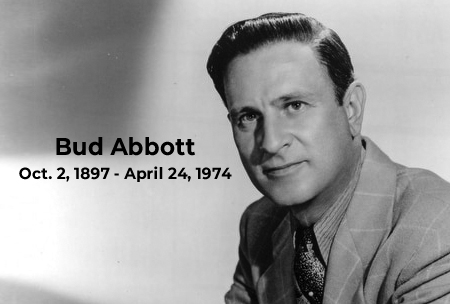Bud Abbott passes away April 24, 1974
Fifty years ago on April 24, Bud Abbott succumbed to cancer. He was 76 years old and his wife, Betty, was at his side.
Bud’s last years were not easy. He was hounded by the IRS and had to sell his home and the rights to his films. He also suffered a series of strokes. Fortunately, he did live to see a revival of interest in his work with Lou Costello, and he readily welcomed fans of every age into his home, where they expressed their appreciation and love for the team.

Bud’s partnership with Lou had dissolved 15 years earlier after 21 years, 36 movies, over 400 radio shows, 52 TV episodes and two dozen live broadcasts. During that time they had been among the most popular and highest paid movie stars. Any hopes of a reunion were dashed after Lou died suddenly in 1959. Bud worked very little after that.
But Bud Abbott had been a reluctant performer to begin with. His daughter, Vickie, once explained, “Dad never really saw himself on the stage. He always saw himself doing what his father did – run up ahead of the show, set things up, and sell tickets. Growing up in that period, you looked for a steady job and a steady income. Performers could work one week and then be off for four, or work five weeks and be off ten. That’s why he was very hesitant to go with Lou or anybody else. Several comics wanted to team up with dad.”
Bud was born into a show business family on October 2, 1897 in Asbury Park, New Jersey. His parents met while working for the Barnum and Bailey Circus. His father, Harry, became a road manager for shows on the preeminent burlesque circuit, the Columbia wheel, in 1902, and stayed with the company until about 1925. In 1917 he got Bud a job as the assistant treasurer of the Casino Theater, a Columbia house, in Brooklyn. A year later, while he was the treasurer of the Casino Theater in Washington, D.C., Bud met and married Betty Smith (née Jennie Mae Pratt), a burlesque dancer, singer and comedienne.
In those days, Bud saw hundreds of burlesque shows and watched dozens of comics and comedy teams perform every classic routine. In 1924 he put together his own small troupe to play rural towns. He wasn’t a performer, but when the show struggled financially, he fired the straight man and took on the role himself. It was a practical decision. But, in a few years, the reluctant performer was working with some of burlesque’s best comedians, including Harry Steppe. In addition to performing, Bud sometimes produced shows, including for the Minskys.
It was at Minsky’s Brooklyn theater in 1933 that Abbott first crossed paths with Costello. There’s no evidence that they worked together then, but two years later, at the Eltinge Theater on 42nd Street, they did. The chemistry was undeniable. Betty once recalled, “They worked wonderfully together. People started to say, ‘Why don’t you team up?’” Vickie Abbott said, “My mom convinced him to go with Lou. She said, ‘Bud, you and Lou are going to be one of the biggest teams ever.’ I remember her telling me this many times. It gives me chills to think about it.”
Betty was, of course, prophetic. Two years after teaming up, they were regulars on the Kate Smith radio show, and two years after that, they were in Hollywood making movies.
It’s easy to overlook or even discount a comedian’s acting ability, but Abbott and Costello were excellent actors. They had to be, to bring to life sketches that had been recycled for decades by countless other teams. The boys were also, by necessity, creative, too; they interpreted that material in unique ways to leave us with the definitive versions of these sketches.
When Bud passed, Groucho Marx called him, “The greatest straight man ever.” Not bad for a reluctant performer.
Bud, however, had no pretensions. He once said, “Once they start calling us ‘artistes,’ we’re dead.” That should be revised to, “Once we’re dead, they start calling us ‘artistes.’”

